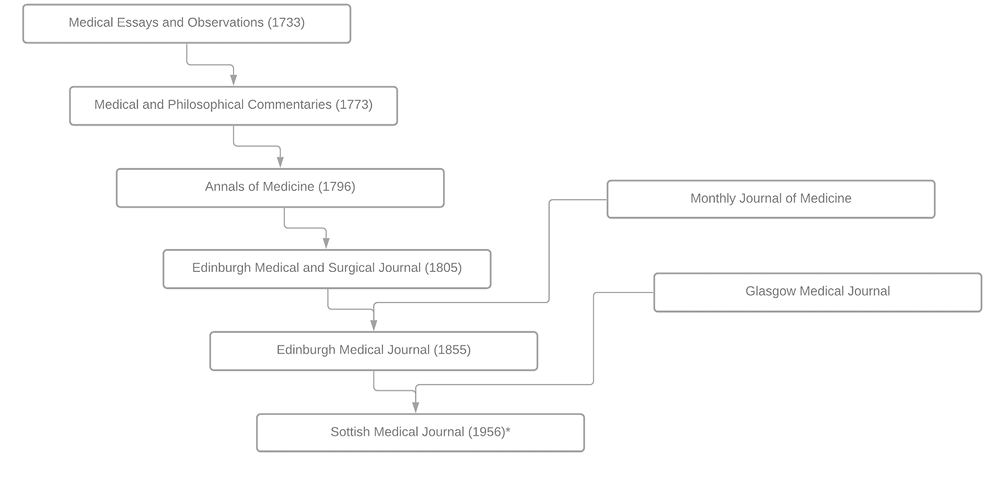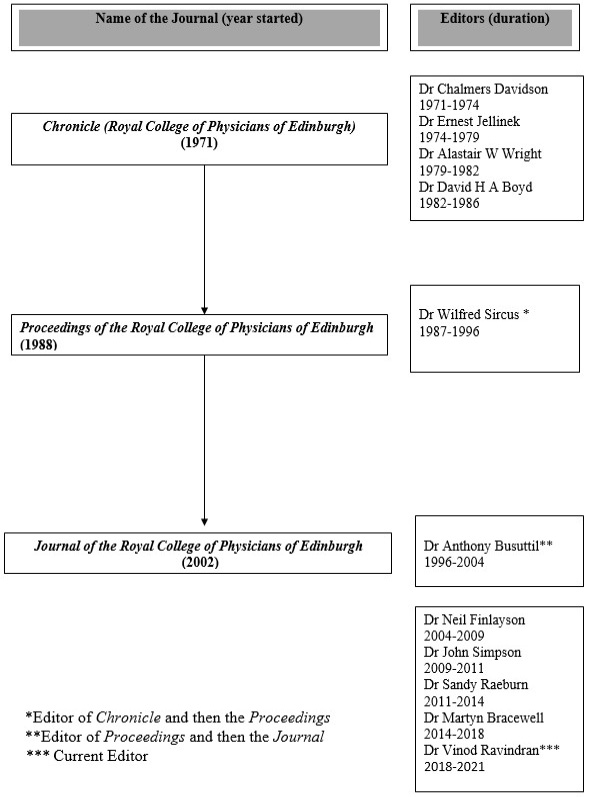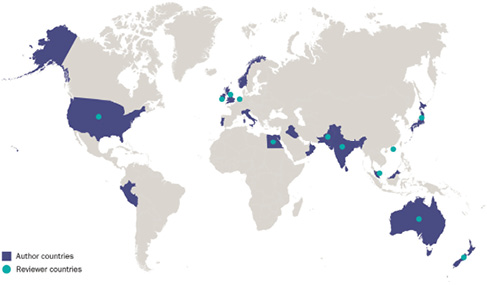The concept of periodic scientific publications or journals dates back to the seventeenth century. Soon after the Royal Society was founded, the then secretary Henry Oldenburg started a scientific journal called Philosophical Transactions of the Royal Society in 1665.1 In the early eighteenth century, the first medical society of Edinburgh, the Society for the Improvement of Medical Knowledge, was set up.2 In 1733, it initiated a publication named Medical Essays and Observations, which was the first noted medical publication from Edinburgh.3 The publication continued until 1765 (with an interruption from 1744–54) when it was interrupted again till 1773 when it reappeared as Medical and Philosophical Commentaries.3 The letters exchanged during the gestational phase of the Commentaries between the editor Andrew Duncan and his publishers John Murray in London and Charles Elliot in Edinburgh reveal how aware they all were of the need for good content as well as language in their upcoming publication.4 In 1796, the Commentaries was renamed as the Annals of Medicine. The Annals continued to evolve and in 1805 acquired a new name, the Edinburgh Medical and Surgical Journal.3 In 1855 it was combined with the Monthly Journal of Medicine to become the Edinburgh Medical Journal. In 1956 the Glasgow Medical Journal merged with the Edinburgh Medical Journal to form the Scottish Medical Journal, which remains in publication today.5 Figure 2 depicts these developments.
Figure 2 Early medical publications from Edinburgh *Still in publication

As the reader might be well aware, the College was founded in 1681 and its Pharmacopoeia Edinburgensis was first published in 1699. This remarkable publication over the next 150 years gave the College international fame and prestige.6 However, a more formal periodic publication was lacking for the better part of the twentieth century, until in 1971, when the Chronicle (Royal College of Physicians of Edinburgh) came into existence. Its mandate was to convey the information from the president, secretary, registrar and council, and about library affairs. Additionally, it included the information on honours and deaths.7 The Chronicle was meant for Fellows and Members only as its content page warned “that the information contained in the Chronicle was restricted to Fellows and Members and was not to be conveyed to the general public or to other journals’! The College in 1984 introduced an additional title called Proceedings of the College, which also published college lectures, case reports and brief communications. With a view of combining these two publications, the Chronicle was renamed as the Proceedings of the Royal College of the Physicians of Edinburgh in 1988.3 From 1988–94 the College also published Current Medicine (four volumes, first one edited by Dr Tony Toft and volumes 2–4 by Dr David Lawson, eventually merging with the Proceedings) with the objective of providing an update in recent advances in medicine covering a broad spectrum complementing the College symposia.
This change in the name not only brought about important changes in its scope (‘we believed that a complete medical education included some familiarity with general literature, the arts and above all, history’) but it also became conscious of the need to have a global outreach.3 Its main content in the science section was commissioned reviews from speakers at the College symposia and on other topics of current interests. It also had reports on symposia and provided a platform for the readers and authors to exchange correspondence and published speeches by writers and politicians at the College, but as such had limited papers reporting original research.3 Subsequently, a ‘lack of peer-review’ was identified as an important reason for very few submissions of clinical and scientific interest. In consideration of this and other factors such as escalating cost of printing, changes were brought in 1998, the major one being the three sections (clinical, continued medical education and history including ‘other non-scientific papers’), each with dedicated editors.8
Still, the Proceedings was not being seen as an attractive proposition in a world where publication in journals with high impact factors had become important to procure future research funding by the authors.9 Relying only on Fellows and Members for original submissions was also not sustainable given their own ever increasing professional and clinical demands. To overcome these challenges, in a major overhaul, in 2002, its third and the current avatar was born as the Journal of the Royal College of the Physicians of Edinburgh with the objective of ‘retaining the more popular elements of the Proceedings whilst increasing its emphasis on current medicine and providing a more focussed, topical and sustainable publication for the College’s worldwide membership’.9 Important changes were inclusion of more topical papers and original content, and reviews of contemporary issues in medicine in the form of clinical opinions. The aforementioned three sections continued until 2008 when they were changed to Clinical, Education and History & Humanities.9 Figure 3 depicts this journey of the College journals.
Figure 3 The 50-year journey of the College Journal

The Journal has since made good progress resulting in increased interest from authors and readers both within the College and outside. In the last 3 years, the current editorial board has taken several key initiatives. While retaining the focus in its three core areas, it has placed greater emphasis on original papers and expert reviews (both topical and full length) bearing in mind the need for a balance between citable and non-citable components, which is important for the Journal’s sustainability. This is supported by proactive–active commissioning strategy not only for reviews but also for editorials, perspectives and clinical opinions. A series of editorials since 2019 on the ethical and technical aspects of bio-medical publications have been well appreciated.10 Streamlined editorial processes with particular attention on the ethical aspects of conducting and reporting research and stringent peer review and feedback to authors have enhanced the reputation of the Journal and helped it gain recognition outside the European continent among researchers and clinicians alike. The editors have been striving to give the first decision within 8–10 weeks of submission for most manuscripts. The Andrew Douglas annual award for original papers on tuberculosis and other granulomatous diseases (first given in 2020) and College Journal Prizes for the trainees for case reports and original papers (supported by the Senior Fellows Club) have helped the cause. As a result, submissions to the Journal have increased substantially and so have the rejection rates, the latter also being an indicator of Journal’s ever improving quality. The Journal has good visibility through its indexing in PubMed, SCOPUS and Embase. In 2018, for the first time it was listed in the Emerging Science Citation Index (ESCI) for its editorial rigour and best practice, and hopefully helped by several of aforementioned measures, it will pass the desired impact criteria and be included in the Science Citation Index Expanded (SCIE). Since 2019, content tracking of the Journal can be carried out through Altmetrics, another valuable addition. Authors and peer reviewers for the Journal now come from all over the globe (Figure 4). Peer reviewers are being formally acknowledged for their much-valued contribution (please see the Decembers issues of 2019 and 2020). The new standalone webpage of the Journal (http://www.rcpe.ac.uk/journal) allows easy access to the published papers to anyone anywhere in the world due to the platinum model of open access publication the College follows for the Journal.
Figure 4 Author and reviewer countries (2018–20)

Despite the continued improvement, there remain some important lacunae (Table 1). The College has been most sympathetic to the Journal’s needs, including of an online manuscript submission system and ahead of print (AOP) facility. It is being hoped that in near future, while the provision of the former shall address the issue of non-homogenous submissions, and resultant increase in the processing workload and man-hours required on each manuscript, the latter will allow authors to gain credit from their accepted manuscripts well before they are eventually assigned a print issue.
Table 1 Challenges to the Journal
|
Challenges
|
Possible solution(s)
|
|
Speedy processing of manuscripts
|
- Online manuscript submission system
- Dedicated editorial staff
- A larger and diversified editorial board
|
|
Handling manuscripts with extensive data
|
- Dedicated statistical editor(s)
|
|
Early availability of papers
|
- Speedy processing of manuscripts
- Ahead of print availability
|
|
Easy and early searchability of the papers on the web
|
- Timely linking of papers to Medline and generation of PubMed identifiers
|
|
Easy searchability of the papers on the Journal website
|
- Facility to search and sort papers by subspecialty and disease conditions (the Journal website currently only allows one to search by paper type)
|
|
Providing author recognition
|
- Asking authors to provide ORCID identifiers
- Linking the Journal (the online versions) to ORCID
|
|
Providing recognition to reviewers and editors
|
- Partner with Publons, which shall enable automatic adding of manuscripts to the reviewer’s Publons account
|
|
Wider visibility of published papers
|
- Asking authors for their social media handles while submitting manuscripts
- Preparing podcasts, short video presentations and infographics of chosen papers
- Dedicated social media editors/team
|
The College now is a large community of nearly 11,000 Fellows and Members spread over 117 countries. The College journals owe their progress over the years to this community of kindred spirits. As the Journal starts its 51st year of its existence, I congratulate each one of them on this fascinating journey and sincerely hope that their contributions as authors, reviewers and flag bearers of the Journal continues to grow. 
Acknowledgements
I would like to thank Dr Mohit Goyal for helping me with his research in to the history of early medical publications from Scotland and Figure 2. I also sincerely thank Ms Daisy Cunynghame and Ms Estela Dukan of the College Library and Heritage team for their assistance.
References
1 Epistle dedicatory. Philosophical Transactions of the Royal Society of London. 1665; 1.
2 Scottish Thought and Letters in the Eighteenth Century. Gla.ac.uk. https://www.gla.ac.uk/myglasgow/library/files/special/exhibns/scottish/s... (accessed 15/02/21).
3 Editorial: the college’s journals: past, present and challenges for the future. J R Coll Physicians Edinb 1996; 26: 1–6.
4 Chalmers I, Tröhler U, Chalmers J. Andrew Duncan’s publications and his relations with his publishers. In: Chalmers J, editor. Andrew Duncan Senior, Physician of the Enlightenment. Edinburgh: National Museums of Scotland Publishing; 2010. pp. 36–55.
5 Hamilton D. The Scottish Medical Journal - the first fifty years. Scottish Med J 2006; 51: 8–12.
6 The Edinburgh Pharmacopoeia. https://www.rcpe.ac.uk/heritage/college-history/edinburgh-pharmacopoeia (accessed 16/02/2021)
7 Editorial. Chronicle of the Royal College of Physicians of Edinburgh 1971; 1: 3–4.
8 Editorial: Changes to proceedings: are they needed? J R Coll Physicians Edinb 1998; 28: 465–7.
9 Editorial: The role of the medical journal. J R Coll Physicians Edinb 2003; 33: 153–6.
10 Misra DP, Ravindran V. Publication misconducts related to copyright: tread carefully to avoid falling! J R Coll Physicians Edinb 2020; 50: 3–5.